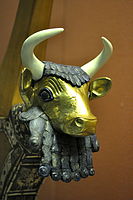First Dynasty of Ur
(26th-25th century BCE)

The First Dynasty of Ur was a 26th-25th century BCE dynasty of rulers of the city of Ur in ancient Sumer.[1] It is part of the Early Dynastic period III of the history of Mesopotamia. It was preceded by the earlier First Dynasty of Kish and the First Dynasty of Uruk.[2]
Rule
According to the Sumerian King List, the final ruler of the First Dynasty of Uruk Lugal-kitun was overthrown by Mesannepada of Ur. There were then four kings in the First Dynasty of Ur: Mesannepada, Mes-kiagnuna, Elulu, and Balulu.[3] Two other kings earlier than Mes-Anepada are known from other sources, namely Mes-kalam-du and A-Kalam-du.[3] It would seem that Mes-Anepada was the son of Mes-kalam-du, according to the inscription found on a bead in Mari, and Mes-kalam-du was the founder of the dynasty.[3] A probable Queen Puabi is also known from her lavish tomb at the Royal Cemetery at Ur. The First Dynasty of Ur had extensive influence over the area of Sumer, and apparently led a union of south Mesopotamian polities.[3][4]
Ethnicity and language
Like other
International trade
The artifacts found in the royal tombs of the dynasty show that foreign trade was particularly active during this period, with many materials coming from foreign lands, such as

The Ur I dynasty had enormous wealth as shown by the lavishness of its tombs. This was probably due to the fact that Ur acted as the main harbour for trade with
Demise

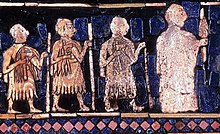
According to the Sumerian King List, the First Dynasty of Ur was finally defeated, and power went to the Elamite Awan dynasty.[10] The Sumerian king Eannatum (c.2500–2400 BCE) of Lagash, then came to dominate the whole region, and established one of the first verifiable empires in history.[11]
The power of Ur would only revive a few centuries later with the Third Dynasty of Ur.[11][12]
List of rulers
| Ruler | Image | Epithet | Length of reign | Approx. dates | Mentions |
|---|---|---|---|---|---|
| (A-Imdugud) | ? | c. 26th century BC | Tomb inscriptions at the Royal Cemetery at Ur | ||
| (Ur-Pabilsag) |  |
? | c. 26th century BC | Tomb inscriptions at the Royal Cemetery at Ur | |
| (Meskalamdug) (Queen Puabi) |
? | c. 26th century BC | Dynastic beads, tomb inscriptions at the Royal Cemetery at Ur | ||
| (Akalamdug) |  |
? | c. 26th century BC | Dynastic beads, tomb inscriptions at the Royal Cemetery at Ur | |
| Mesannepada | 80 years | c. 26th century BC | Tummal Chronicle
| ||
| A'annepada | "son of Mesh-Ane-pada" | ? | c. 26th century BC | Dedication tablets with inscriptions | |
Mesh-ki-ang-Nanna |
 |
"son of Mesh-Ane-pada" | 36 years | Tummal Chronicle
| |
| Elulu | 25 years | Sumerian King List | |||
| Balulu | 36 years | Sumerian King List | |||
Sumerian King List
Only the final kings of the First Dynasty of Ur, from Mesannepada to Balulu and possibly 4 unnamed kings, are mentioned in the Sumerian King List:[13]
"...
Mesh-ki-ang-Nanna, son of Mesannepada, was king, 36 years he ruled; Elulu, 25 years he ruled; Balulu, 36 years he ruled; 4 kings, the years: 171(?) they ruled. Ur with weapons was struck down; the kingship to Awan was carried off.— Sumerian King List, 137-147.[14]
Artifacts
The Royal Cemetery of Ur held the tombs of several rulers of the First Dynasty of Ur.[3] The tombs are particularly lavish, and testify to the wealth of the First Dynasty of Ur.[4] One of the most famous tombs is that of Queen Puabi.[4]
-
A gold dagger and a dagger with a gold-plated handle, Ur excavations (1900).
-
Reconstructed Sumerian headgear necklaces found in the tomb of Puabi, housed at the British Museum
-
Queen's Lyre, one of the Lyres of Ur, Ur Royal Cemetery.
-
The Standard of Ur
-
Lyre of a Bull's Head from Queen Puabi's tomb. (British Museum)
-
Nacre plate with anthropomorphic animals, circa 2600 BCE
See also
References
- ISBN 9780521070515.
- ISBN 9781438126760.
- ^ ISBN 9781442690479.
- ^ ISBN 9780226144672.
- ISBN 9780191623325.. Mention of Gen 11:2"And as people migrated from the east, they found a plain in the land of Shinar and settled there." (English Standard Version)
- ISBN 9780802837813.
- ^ a b British Museum notice: "Gold and carnelians beads. The two beads etched with patterns in white were probably imported from the Indus Valley. They were made by a technique developed by the Harappan civilization" Photograph of the necklace in question
- ^ a b c British Museum notice "Grave goods from Ur"
- ISBN 9781576079072.
- ISBN 9781782395676.
- ^ ISBN 9781438126760.
- ISBN 9780534106454.
- ^ "CDLI-Found Texts". cdli.ucla.edu.
- ^ "CDLI-Found Texts". cdli.ucla.edu.
- ^ British Museum notice WA 121544
- ISBN 9781136219115.
- ISBN 9780924171550.
- ISBN 9781119025542.




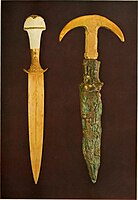
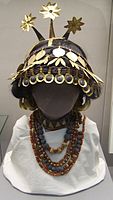
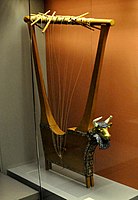
![Cylinder seal of Queen Puabi, found in her tomb. Inscription 𒅤𒀀𒉿 𒊩𒌆Pu-A-Bi-Nin "Queen Puabi".[15][16][17] The last word "𒊩𒌆" can either be pronounced Nin “lady”, or Eresh “queen”.[18]](http://upload.wikimedia.org/wikipedia/commons/thumb/2/20/Flickr_-_Nic%27s_events_-_British_Museum_with_Cory_and_Mary%2C_6_Sep_2007_-_185.jpg/200px-Flickr_-_Nic%27s_events_-_British_Museum_with_Cory_and_Mary%2C_6_Sep_2007_-_185.jpg)


